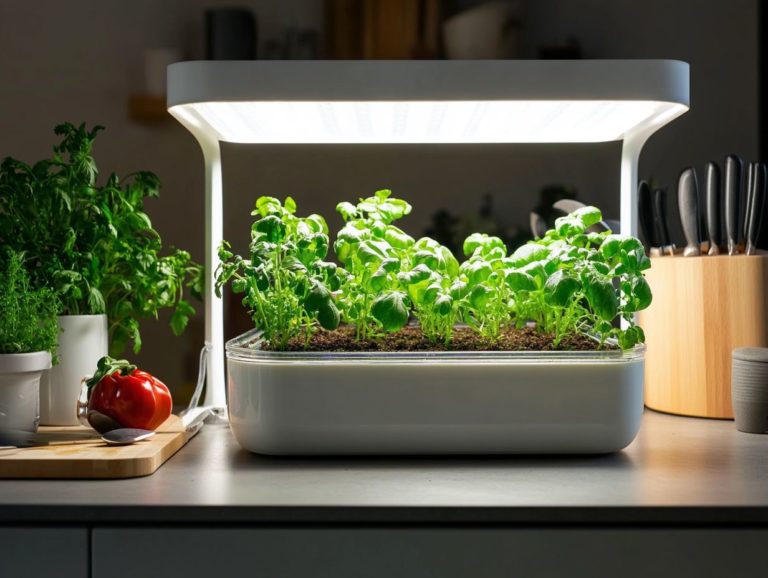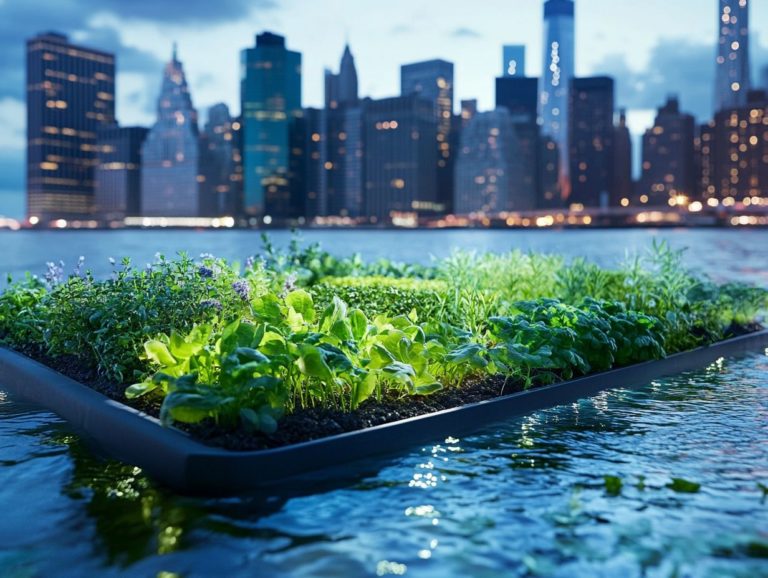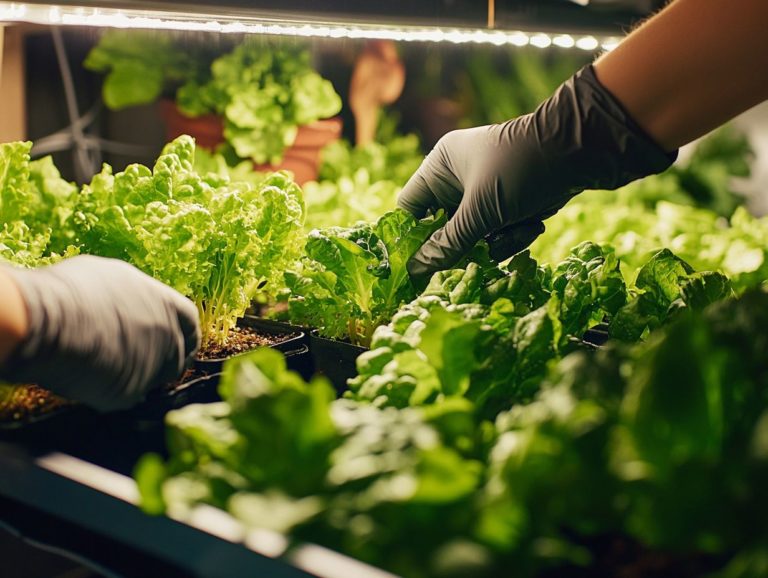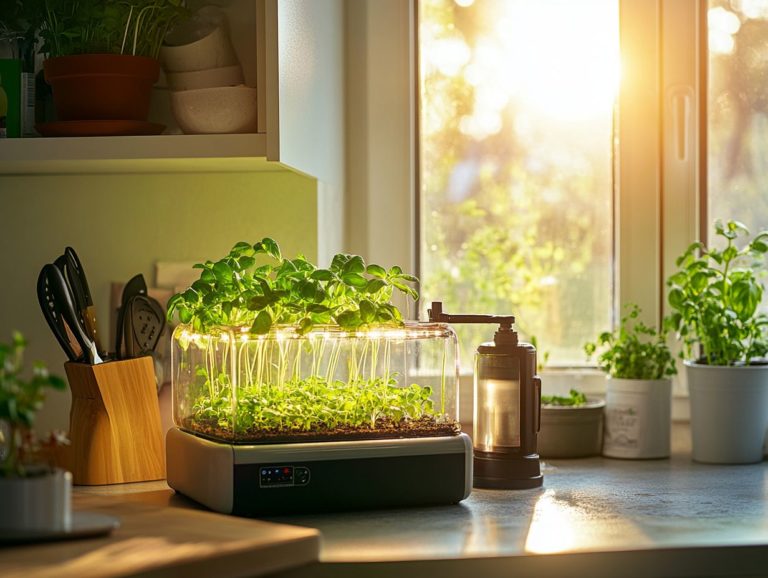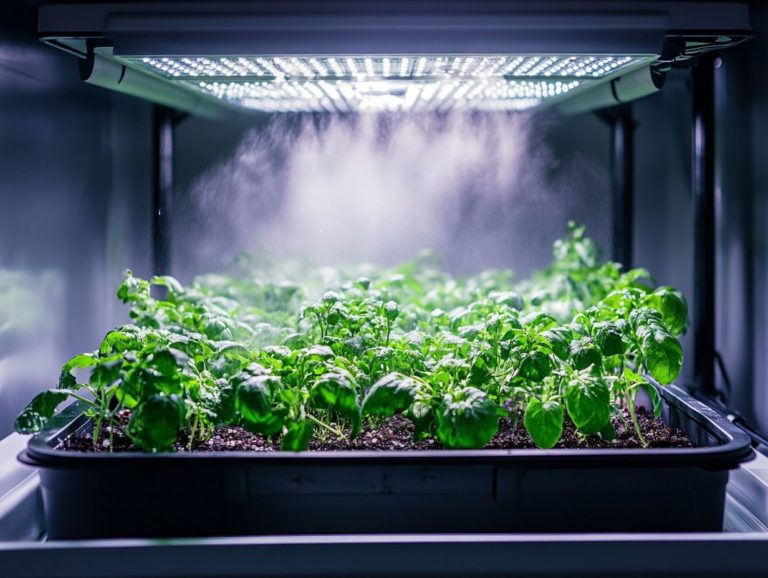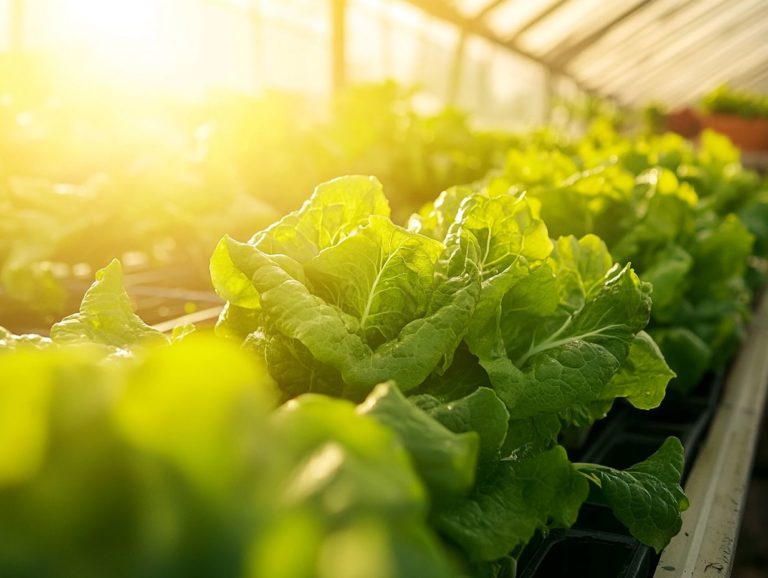How to Teach Kids About Hydroponics?
Hydroponics presents a unique opportunity to grow plants without soil, immersing kids in hands-on learning about science, sustainability, and nutrition. This article delves into the myriad benefits of introducing children to hydroponics, highlighting its educational and environmental advantages while providing practical guidance for setting up a hydroponic system.
With a wealth of activities, lesson ideas, and troubleshooting tips, you ll uncover ways to inspire the next generation to cultivate their green thumbs through this innovative approach to gardening.
Contents
- Key Takeaways:
- Benefits of Teaching Kids About Hydroponics
- Getting Started with Hydroponics
- Teaching Kids the Basics of Hydroponics
- Advanced Concepts and Projects
- Incorporating Hydroponics into the Classroom
- Troubleshooting and Maintenance
- Frequently Asked Questions
- What is hydroponics and why is it important to teach kids about it?
- How can I introduce hydroponics to my child?
- Are there any age restrictions for teaching kids about hydroponics?
- What are some fun activities to help kids learn about hydroponics?
- How can I make learning about hydroponics more interactive and engaging for kids?
- What are the long-term benefits of teaching kids about hydroponics?
Key Takeaways:

- Introduce kids to the concept of hydroponics as a sustainable and educational way to grow plants.
- Teach kids about hydroponics through hands-on activities and projects, such as designing and building their own hydroponic garden.
- Incorporate hydroponics into the classroom to enhance learning in various subjects and promote environmental awareness.
What is Hydroponics?
Hydroponics is a revolutionary way to grow plants without the need for soil, harnessing nutrient solutions delivered directly to the roots. This technology not only promotes efficient plant growth but also requires less space and water, allowing fast-growing plants to thrive making it an exceptional choice for sustainable gardening.
With hydroponics, you can cultivate edible greens and vegetables in controlled environments, fostering environmental education and deepening your understanding of plant science. Dating back to ancient civilizations, hydroponics has evolved remarkably over the centuries and is gaining traction in modern agriculture due to its many advantages.
Unlike traditional gardening, where soil quality and environmental factors can significantly sway results, hydroponic systems provide a more predictable and regulated growing environment. This method optimizes space and offers impressive germination rates, drastically cutting the cultivation time for various plants grown for food.
Hydroponics also conserves water, aligning perfectly with sustainable gardening principles that resonate with eco-conscious growers. As urban areas expand, the ability to cultivate food vertically and in compact spaces underscores hydroponics as a viable solution for food security and resource management.
Benefits of Teaching Kids About Hydroponics
Teaching kids about hydroponics offers a wealth of benefits that extend far beyond the classroom. It significantly enhances their engagement in STEM education, deepens their understanding of environmental issues, and equips them with practical skills in sustainable gardening practices.
By utilizing hydroponic systems as an educational tool, children can dive into the world of plant growth, experimenting and gaining hands-on experience. This fosters their curiosity while nurturing a profound connection to nature that will last a lifetime.
Educational and Environmental Advantages
The educational and environmental benefits of hydroponics are remarkable. It provides a unique opportunity to understand essential plant needs and the intricate lifecycle of plants while cultivating a sense of responsibility towards the environment.
Engaging in hydroponics allows you to explore concepts like lack of nutrients, water requirements, and light needs, transforming science into an accessible and enjoyable experience. This hands-on approach enhances involvement in science projects and deepens your understanding of ecosystems.
Imagine incorporating hydroponic systems into your school curriculum. You could create mini-gardens to monitor plant growth and the effects of different nutrient solutions. You can even conduct experiments showcasing the importance of water conservation and the role of photosynthesis. These activities sharpen practical skills while fostering teamwork and problem-solving abilities, making your learning experience dynamic and highly relevant.
Now is the perfect time to get your children involved in hydroponics. Start exploring how easy it can be to set up a system at home!
Getting Started with Hydroponics
Embarking on your hydroponics journey is an exhilarating endeavor that requires a few key supplies and an understanding of vital components like nutrient solutions the liquid that provides plants with the nutrients they need to grow and growing media.
No matter if you re working with a simple 2-liter bottle, coconut coir, or crafting your own hydroponics system, laying down the right foundation for your setup is essential for achieving thriving plant growth and embracing sustainable gardening practices.
Supplies and Set-Up

The right supplies and proper setup are crucial for your hydroponic system’s success. You ll need everything from a simple 2-liter bottle and aluminum foil to more specialized components like hydroponic nutrient solutions. Knowing which supplies matter will empower you to create a thriving indoor garden that yields fast-growing plants.
A hydroponic garden requires a variety of essential materials think growing mediums, pH testing kits, and light fixtures to ensure optimal growth conditions. You can choose from various systems, such as nutrient film technique (NFT) and deep water culture (DWC), each offering unique advantages based on the plants you re cultivating.
Gathering the necessary tools is crucial for effective water management. You ll need pumps, timers, and reservoirs to manage water circulation effectively. For sourcing these supplies, both local garden stores and online marketplaces like Amazon can be invaluable. They provide everything from basic equipment to advanced hydroponic kits. Exploring your options ensures your setup meets your gardening needs and fits your budget.
Teaching Kids the Basics of Hydroponics
Engaging children in the fundamentals of hydroponics through hands-on learning activities can ignite their passion for plant science and foster genuine involvement. By immersing them in practical experiences, they have the opportunity to witness plant growth up close, comprehend the principles underpinning hydroponic techniques, and master essential concepts like nutrient absorption and light requirements.
Hands-On Learning Activities
Engaging in hands-on learning activities in hydroponics can truly elevate your understanding of scientific principles, transforming education into a delightful and interactive experience. Consider experimenting with the germination rates of various seeds or trying out different planting techniques these activities not only captivate but also deepen your comprehension of the practical applications of classroom concepts.
These exploratory sessions ignite curiosity and nurture a sense of responsibility as you care for your plants, monitoring their growth and adjusting nutrient solutions based on what you observe. Whether you’re conducting experiments in a traditional classroom, tending to an outdoor garden, or collaborating in a community center, the myriad methods of planting and caring for crops weave a rich tapestry of learning experiences.
By grasping how nutrient solutions influence plant health, you can bridge the gap between theoretical knowledge and real-world scenarios, solidifying your understanding of biology and environmental science in a way that is both enjoyable and memorable.
Advanced Concepts and Projects
Exploring advanced concepts and projects in hydroponics can significantly enhance your learning experience, enabling you to apply foundational knowledge to real-world scenarios.
These projects may encompass designing your own hydroponic systems or engaging in community garden initiatives, fostering collaboration while enriching your understanding of environmental education.
Exploring Different Hydroponic Systems
Exploring different hydroponic systems is a remarkable opportunity to engage with practical science while observing the fascinating growth of plants. Each method, from the wick system to the nutrient film technique, unveils unique insights into how liquids that help plants grow are delivered, sparking curiosity and encouraging inquiry.
Take the wick method, for example it’s perfect for beginners. It uses a wick to transport nutrients directly from a reservoir to the plant roots. The nutrient film technique, on the other hand, offers a continuous flow of nutrient solution, enhancing oxygen exchange and optimizing plant growth.
Meanwhile, deep water culture immerses roots in a nutrient-rich environment, ensuring ample oxygen and nutrient absorption. Understanding these systems helps you appreciate the critical role of tailored nutrient solutions, which vary in composition and delivery based on the hydroponic method used. Dive into this exciting journey and see how plants thrive!
Designing and Building a Hydroponic Garden
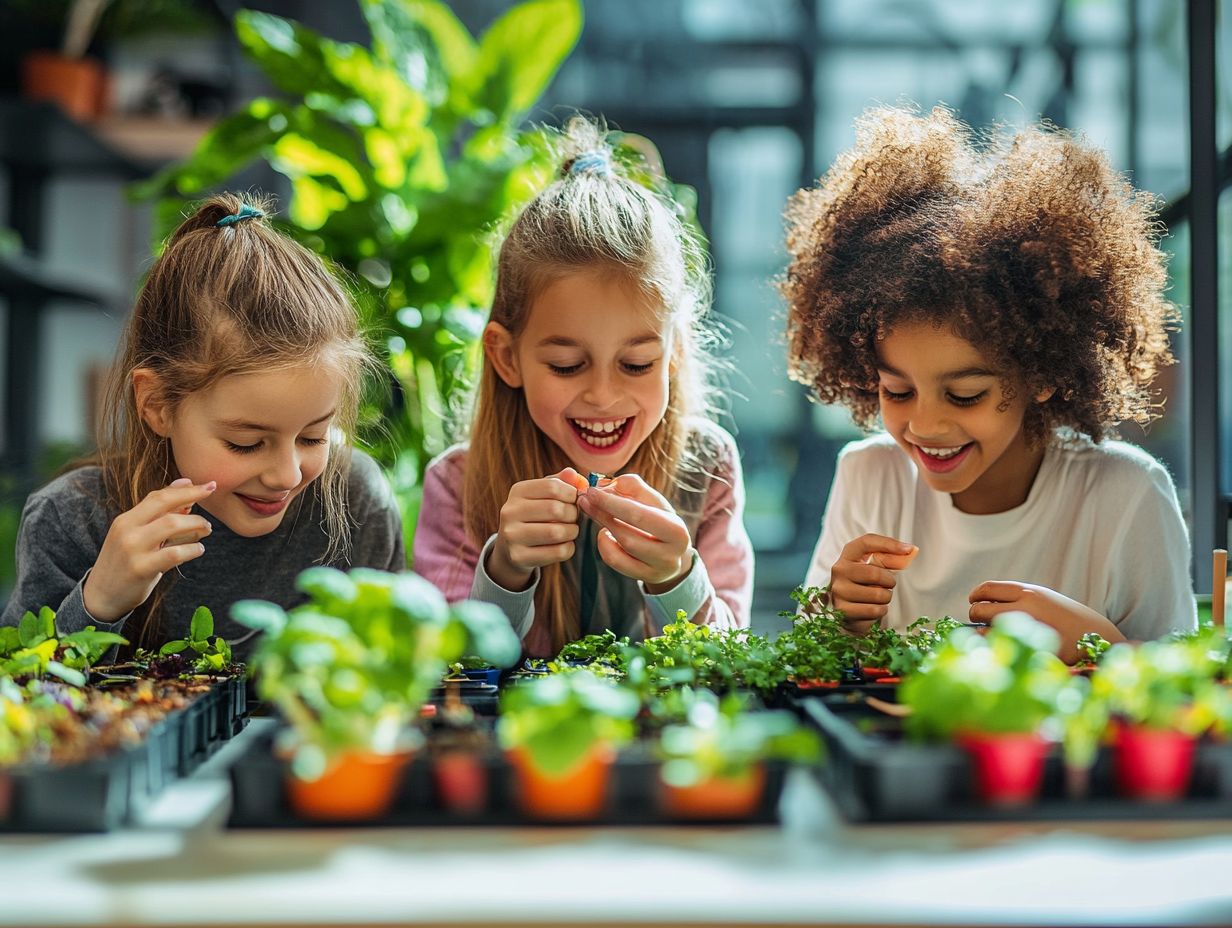
Designing and building a hydroponic garden offers a rewarding experience that ignites creativity while deepening your understanding of plant needs and sustainable gardening. As you collaborate, you’ll discover the essential components required for a successful hydroponic setup. Learn how to meet the water needs of your plants and apply your knowledge in a practical way.
- Select a space that receives ample natural light crucial for thriving plants. Consider using a 2-liter bottle for smaller projects.
- Choose the right materials, like nutrient solutions, containers, and growing media such as coconut coir, enjoying a hands-on lesson in sustainability.
- Decide on plant varieties perhaps some aromatic herbs like Genovese Sweet Basil or vibrant leafy greens such as Black Seeded Simpson and discuss how to meet their unique needs within your hydroponic system.
Encouraging teamwork, get creative and design your garden layout, sparking innovative ideas and fostering ownership over your project. Each decision will significantly impact the overall health and yield of your garden, making this a deeply fulfilling educational endeavor.
Incorporating Hydroponics into the Classroom
Incorporating hydroponics into your classroom elevates the educational experience, offering students hands-on opportunities to engage with plant science in a meaningful way, especially through school projects that highlight hydroponic education.
By weaving hydroponic systems into your curriculum, you can cultivate dynamic learning environments that spark curiosity and nurture real-world problem-solving skills among students, enhancing their engagement with STEM education.
Lesson Plan Ideas
Creative lesson plan ideas centered around hydroponics are exceptional educational tools. Consider experiments with nutrient solutions, insightful discussions on plant needs, and collaborative projects that enhance learning and retention.
Imagine building a simple hydroponic system using a 2-liter bottle, PVC pipes, or recycled plastic containers, transforming your classroom into a mini greenhouse. Investigate variables such as light exposure, water pH, and nutrient concentration, while experimenting with different soil alternatives and documenting your findings.
Integrating technology like monitoring sensors or growth apps can further enrich your understanding of plant growth cycles. This real-world application sparks curiosity and nurtures critical thinking and teamwork, ensuring you are thoroughly immersed in the learning experience.
Troubleshooting and Maintenance
Troubleshooting and maintenance are essential components of thriving hydroponic gardening. They ensure that your plants receive the meticulous care they need for optimal growth.
By understanding common challenges like nutrient deficiencies and water quality, including issues related to chlorinated water and light requirements, you empower both educators and students to manage their hydroponic systems effectively.
Common Issues and How to Address Them
Common issues in hydroponics can stifle plant growth and undermine overall system performance. Recognizing these challenges equips you for effective troubleshooting.
Nutrient deficiencies, poor water quality, and improper light exposure often top the list of frequent problems. Tackling these concerns is vital for maintaining vibrant, healthy plants.
Routine maintenance and regular monitoring are essential in preventing issues from spiraling out of control. Consistently checking the pH levels of your nutrient solutions can significantly reduce the risk of nutrient lockout.
Regularly cleaning reservoir systems ensures optimal water quality. Positioning your grow lights correctly enhances photosynthesis, encouraging robust growth.
Proactively managing these elements, including monitoring water needs and conducting harvesting vegetables sessions, helps you cultivate an environment where your plants thrive.
Frequently Asked Questions
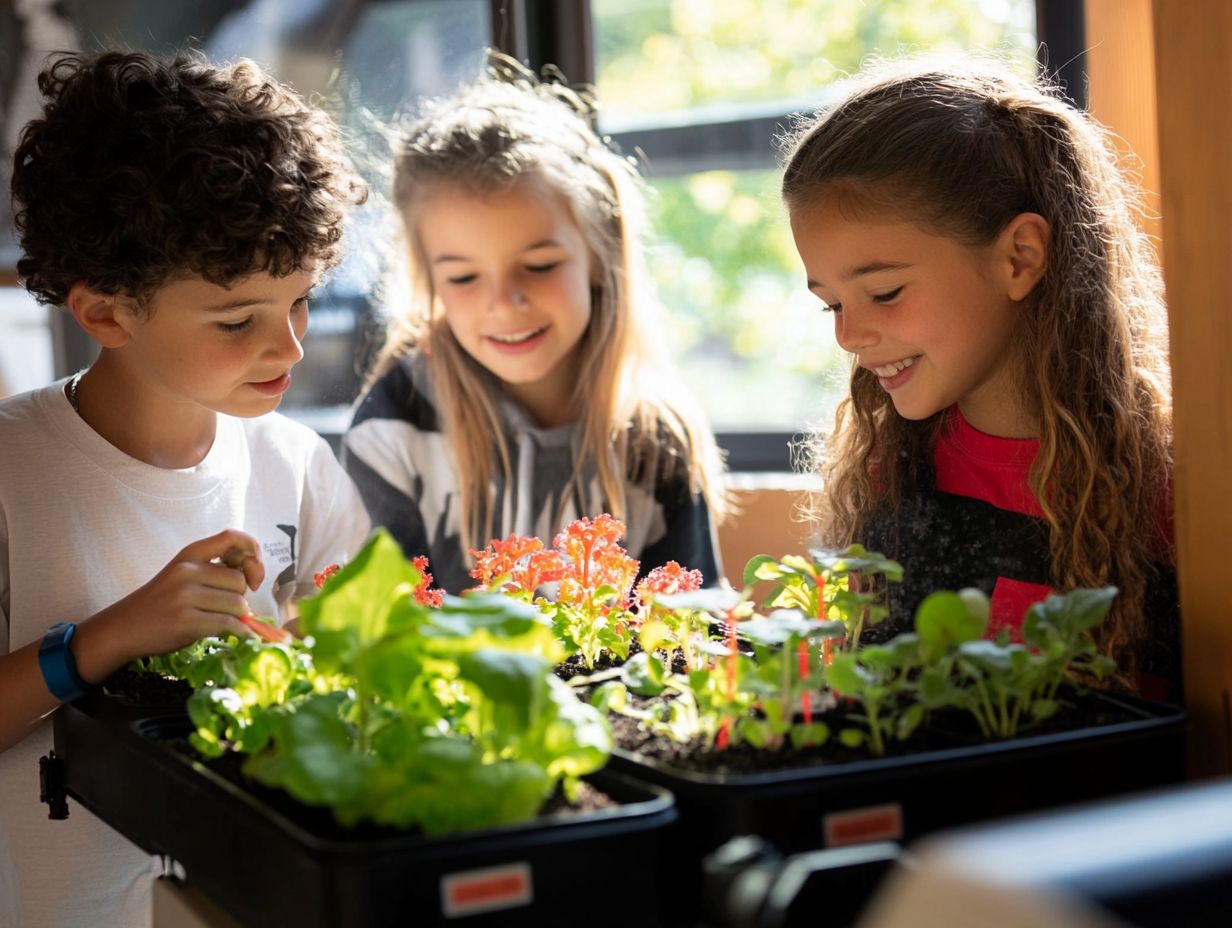
What is hydroponics and why is it important to teach kids about it?
Hydroponics is a method of growing plants in a nutrient-rich water solution without using soil. Teaching kids about it promotes sustainable and efficient agricultural practices and encourages scientific thinking.
How can I introduce hydroponics to my child?
Start by explaining the basics of hydroponics and its benefits. Involve them in setting up a simple hydroponic system using everyday materials.
Consider visiting a hydroponic farm or attending a workshop on hydroponics together.
Are there any age restrictions for teaching kids about hydroponics?
No, hydroponics can be taught to children of all ages. Younger kids may need more supervision, while older kids can take on more responsibility and learn advanced techniques.
What are some fun activities to help kids learn about hydroponics?
Kids can enjoy activities like creating a DIY hydroponic herb garden using seed starters. They can conduct experiments to see how different plants grow in a hydroponic system.
They can even design and build their own hydroponic system with materials from Amazon.
How can I make learning about hydroponics more interactive and engaging for kids?
Involve kids in every step of the hydroponic process, from selecting seeds to harvesting the plants. Get creative with games, quizzes, and hands-on activities to make learning fun and exciting!
What are the long-term benefits of teaching kids about hydroponics?
Teaching kids about hydroponics can promote sustainable and eco-friendly practices. It fosters a love for science and agriculture, encourages experimenting with plants, and helps develop important skills like problem-solving and responsibility.

